.
![]()
Facebook sees a world beyond gaming and entertainment for its virtual reality headset, meaning social networking will soon take a step into VR if the company gets its way: photo by Tom Dymond/REX via the Guardian, 27 March 2015
Beyond gaming
![]()
Beijing, China. A model walks the runway during China fashion week: photo by Feng Li via The Guardian, 26 March 2015
![]()
Beijing. Officials talk through a painted backdrop of the Great Wall of China before the arrival of the Sri Lankan president, Maithripala Sirisena: photo by Feng Li via The Guardian, 26 March 2015
![]()
Panda costumes hang at the Wolong National Nature Reserve in China, Keepers who interact with the pandas must wear costumes in order to mimic conditions of the wild. The costumes are made to smell like pandas too: photo by Ami Vitale via The Guardian, 23 April 2014
![]()
Keepers move a panda to a new part of the reserve as part of its training at the Wolong National Nature Reserve in China. Pandas learn to find their own food and water, look for shelter and become aware of their environment: photo by Ami Vitale via The Guardian, 23 April 2014
![]()
![]()
Panda keepers wait for a panda to leave its cage into the Wolong National Nature Reserve at the Wolong National Nature Reserve in China: photo by Ami Vitale via The Guardian, 23 April 2014
![A Chinese researcher dressed in a panda costume]()
A researcher dressed in a panda costume puts a panda cub into a box before its physical examination at the Hetaoping Research and Conservation Centre for the Giant Panda in Wolong National Nature Reserve, China: photo by Reuters via The Guardian, 7 December 2010
![]()
Four giant pandas at a Chinese rescue centre have died from the canine distemper virus: Photograph: AFP via The Guardian, 6 February 2015
Beyond Gaming: The Shrinking World of the Living: Pablo Neruda: Keeping Quiet
![]()
A golden langur on an island in the Umananda river in Guwahati, in Assam. The langur is one of India’s most endangered primates: photo by Partha Hazarika/Barcroft India via the Guardian, 27 March 2015
Now we will count to twelve
and we will all keep still.
![]()
Kolkata, India. Jalada Prasad, a six-month-old male Indian one-horned rhinoceros, runs around his enclosure on his debut in front of the public at Alipore Zoological Garden: photo by Bikas Das/AP via The Guardian, 27 March 2015
For once on the face of the earth,
let's not speak in any language;
let's stop for one second,
and not move our arms so much.
![]()
An Indian one horned rhino in the Kaziranga national park, Assam, India. The park is a rhino sanctuary and is helping to revive the species and protect them from poachers: photo by Paul Hilton/HSI via The Guardian, 8 January 2015
It would be an exotic moment
without rush, without engines;
we would all be together
in a sudden strangeness.
![]()
Naypyitaw, Burma. A baby elephant, which was found in a river during the rainy season, plays with white elephants, seen as sacred signs of good fortune, peace and wealth: photo by Damir Sagolj / Reuters via The Guardian, 12 November 2014
Fisherman in the cold sea
would not harm whales
and the man gathering salt
would look at his hurt hands.
![]()
Mahouts return home with their elephantscarrying grass to feed them on the eve of the rhino census in Kaziranga national park in Assam, India: photo by TR/EPA via The Guardian, 27 March 2015
Those who prepare green wars,
wars with gas, wars with fire,
victories with no survivors,
would put on clean clothes
and walk about with their brothers
in the shade, doing nothing.
![]()
Assam, India. Forest officials count rhinos during a census at Kaziranga national park. The census takes place every two years, with 2,329 rhinos counted in 2013: photo by Biju Boro/AFPvia The Guardian, 27 March 2015
What I want should not be confused
with total inactivity.
Life is what it is about;
I want no truck with death.
![]()
Rasuruan, Indonesia. A seven-day-old female Sumatran elephant calf stands with its mother at the Safari zoo. Smallest of the Asian elephants, Sumatran elephant (Elephas maximus sumatrensis) is facing serious pressures arising from illegal logging and associated habitat loss, and fragmentation in Indonesia: photo by Fully Handoko / EPA via The Guardian, 14 November 2014
If we were not so single-minded
about keeping our lives moving,
and for once could do nothing,
perhaps a huge silence
might interrupt this sadness
of never understanding ourselves
and of threatening ourselves with death.
Perhaps the earth can teach us
as when everything seems dead
and later proves to be alive.
![]()
A billboard in Hanoi, Vietnam, reads: ‘Rhino horns are just like buffalo horns, human hair and nail. Do not waste your money,’ to mark the World Rhino Day on 22 September. This year’s theme was ‘Five rhino species forever.’: photo by Luong Thai Linh/EPA via The Guardian, 26 September 2014
![]()
A herd of wild elephants with newborns crosses a tea garden to enter a paddy field in Sonitpur, Assam, India. According to reports, five people have been killed by the herd in the last two months and it has destroyed a large area of ripe paddy fields: photo by STR/EPA via The Guardian, 28 November 2014
![]()
![]()
Two sun bears (Helarctos malayanus) at the Vietnam Bear rescue centre in Tam Dao national park, Vietnam. The bear’s gall bladders are used in traditional Chinese medicine and although bile is milked from commercially farmed bears, wild bears are often taken to stock or restock these small farms. Bear meat, particularly the paws, is considered a culinary delicacy. Killing bears is illegal in all bear range countries but is largely uncontrolled. The species is extinct in Singapore and has possibly become extinct in Bangladesh and China. They are banned from international commercial trade: photo by Luong Thai Linh/EPA via the Guardian, 5 February 2015
![]()
Proboscis monkey (Nasalis larvatus). This endangered species is endemic to Borneo and found in Brunei, Indonesia (Kalimantan) and Malaysia (Sabah and Sarawak). It is poached for the illegal pet trade and bush meat, and is also hunted for bezoar stones, an intestinal secretion, used in traditional medicine. In Sarawak, less than 1,000 animals are thought to remain with populations in Borneo ranging between 1,000 and just 100. Banned from international commercial trade: photo by Suzi Eszterhas/Corbis via the Guardian, 5 February 2015
![]()
Asian rhino (Rhinocerotidae spp.). There are fewer than 4,000 wild rhinos in Asia. All three Asian species are highly targeted for their horns. Two, the Javan and Sumatran rhinos are critically endangered. The animals are killed and their horns sawn off and smuggled to their destination markets in Asia: photo by STR/EPA via the Guardian, 5 February 2015
![]()
Burmese pythons (Python bivittatus) are among the most heavily traded species in Southeast Asia with approximately 340,000 skins exported annually for use in the fashion industry.Although more than 20% of exports are declared as captive-bred, a Traffic report argues that the cost of breeding, feeding and maintaining the snakes to reach slaughter size appears much higher than the market price. A skin sold in an Indonesian village for $30 can fetch up to $15,000 as a python skin handbag from a famous fashion house: photo by Mark Conlin/Alamy via the Guardian, 5 February 2015
![]()
The Burmese star tortoise (Geochelone platynota), is a critically endangered species native to Burma. It is used for meat and traditional medicines in Asia and is highly sought after for the international pet trade, with collectors in Europe and North America willing to pay thousands of dollars for an individual. There are concerns that there may now be no viable wild populations. Commercial harvest and trade of this species is illegal under Burmese law, although export of captive specimens is permitted from one facility within the country, which also contributes to a future release program: photo by Minden Pictures/Corbis via the Guardian, 5 February 2015
![]()
A slow loris carried by a wildlife department official in Kuala Lumpur. It was among animals estimated to be worth $20,000, including juvenile eagles and a Malayan sun bear cub, seized during an operation against illegal wildlife traders earlier this month: photo by Olivia Harris/Reuters via the Guardian, 27 March 2015
![]()
Sunda pangolin (Manis javanica) are among the most trafficked mammals in Asia.Sunda pangolin are critically endangered and IUCN reports that wild populations have halved in the past 15 years. They are in high demand both for their meat and for their scales, which are used in traditional medicine — and as love charms. Tens of thousands of Sunda pangolins have been poached from the wild, headed primarily to China where it is considered a luxury food: photo by Rungroj Yongrit/EPA via the Guardian, 5 February 2015
![]()
![]()
A critically endangered pangolin curls up into a ball to resemble a giant pine cone as a poacher nears the tree where it is trying to hide: photo by Paul Hilton for WildAid via the Guardian 10 March 2015
![]()
A poacher catches a juvenile sunda pangolin in Indonesia: photo by Paul Hilton for WildAid via the Guardian 10 March 2015
![]()
![]()
![]()
A poacher holds up the skin of a pangolin with the scales still attached: photo by Paul Hilton for WildAid via the Guardian 10 March 2015
![]()
The sunda pangolin (Manis javanica) is one of two Asian species of pangolin listed as critically endangered on the IUNC red list: photo by Paul Hilton for WildAid via the Guardian 10 March 2015
![]()
Pangolin are a bit like a friendly, flightless dragons. Many of them have no problem being around people: photo by Paul Hilton for WildAid via the Guardian 10 March 2015
![]()
Palm oil plantations, such as this one covering thousands of hectares, are causing habitat-loss for many Indonesian species, although pangolins are one of a few that have limited tolerance to palm-oil habitats. The average monthly wage for an Indonesian working full-time on a plantation is $47 and many turn to poaching because they can earn 10 times as much: photo by Paul Hilton for WildAid via the Guardian 10 March 2015

Facebook sees a world beyond gaming and entertainment for its virtual reality headset, meaning social networking will soon take a step into VR if the company gets its way: photo by Tom Dymond/REX via the Guardian, 27 March 2015
Beyond gaming
there's nowhere
left but here

Beijing, China. A model walks the runway during China fashion week: photo by Feng Li via The Guardian, 26 March 2015

Beijing. Officials talk through a painted backdrop of the Great Wall of China before the arrival of the Sri Lankan president, Maithripala Sirisena: photo by Feng Li via The Guardian, 26 March 2015
Beyond Gaming: The Limitations of Mimicry

Panda costumes hang at the Wolong National Nature Reserve in China, Keepers who interact with the pandas must wear costumes in order to mimic conditions of the wild. The costumes are made to smell like pandas too: photo by Ami Vitale via The Guardian, 23 April 2014
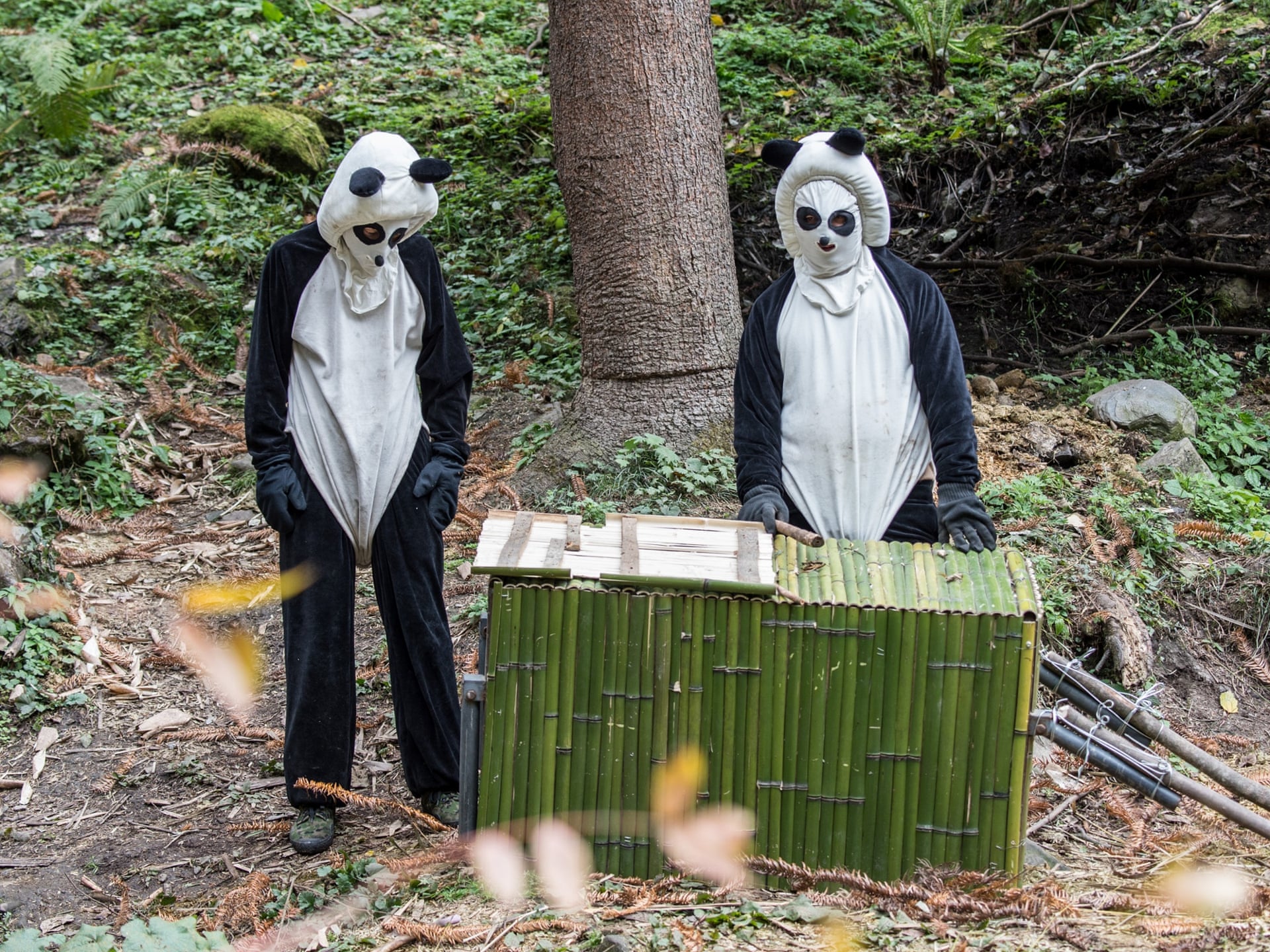
Keepers move a panda to a new part of the reserve as part of its training at the Wolong National Nature Reserve in China. Pandas learn to find their own food and water, look for shelter and become aware of their environment: photo by Ami Vitale via The Guardian, 23 April 2014
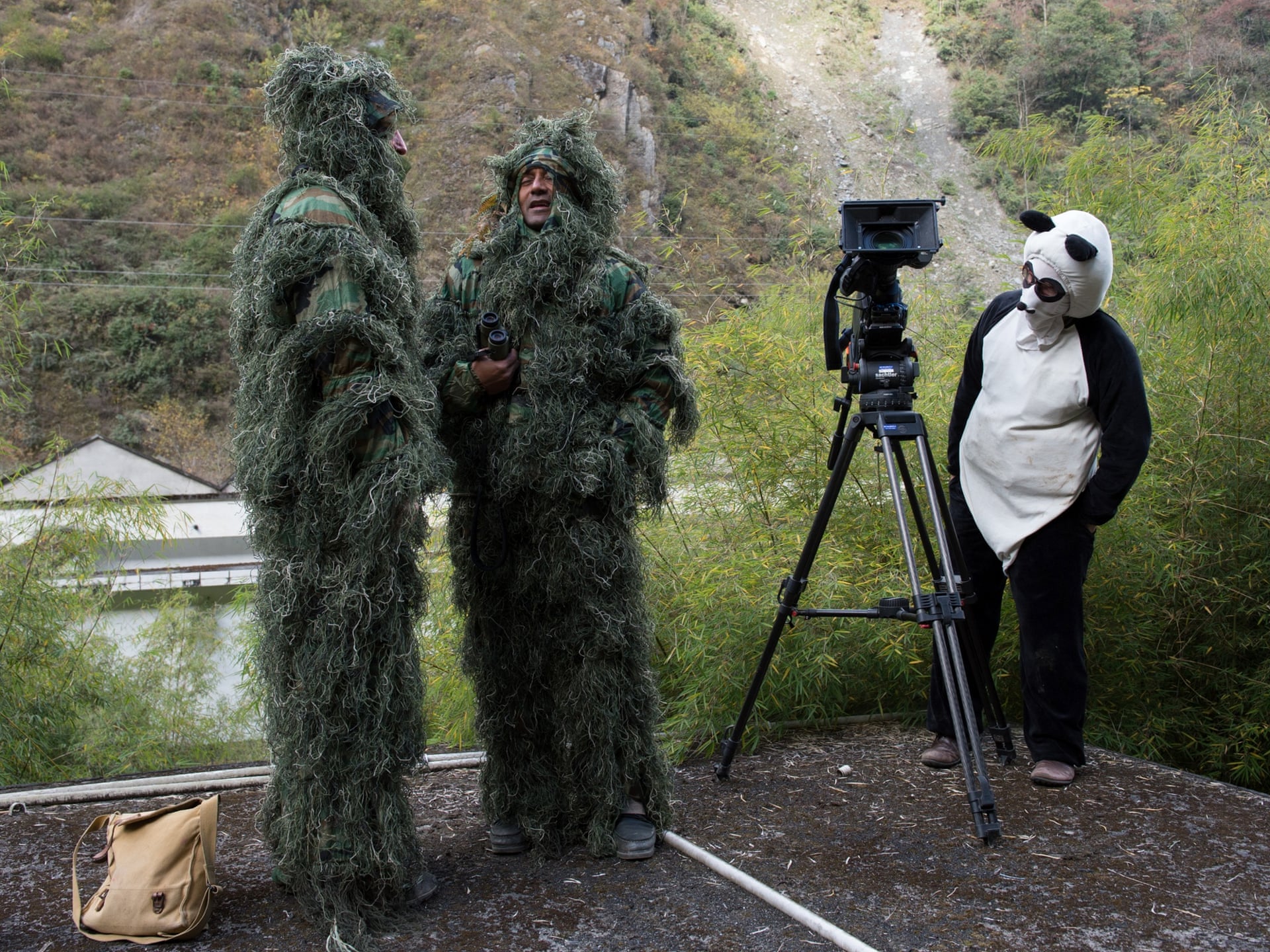
Wolong National Nature Reserve, China. Director Nicolas Brown and Dr. M. Sanjayan, dressed as trees, wait with cameraman Robin Cox in the panda suit to film a new series to air next year on wildlife and humans for PBS and National Geographic TV: photo by Ami Vitale via The Guardian, 23 April 2014
![]()
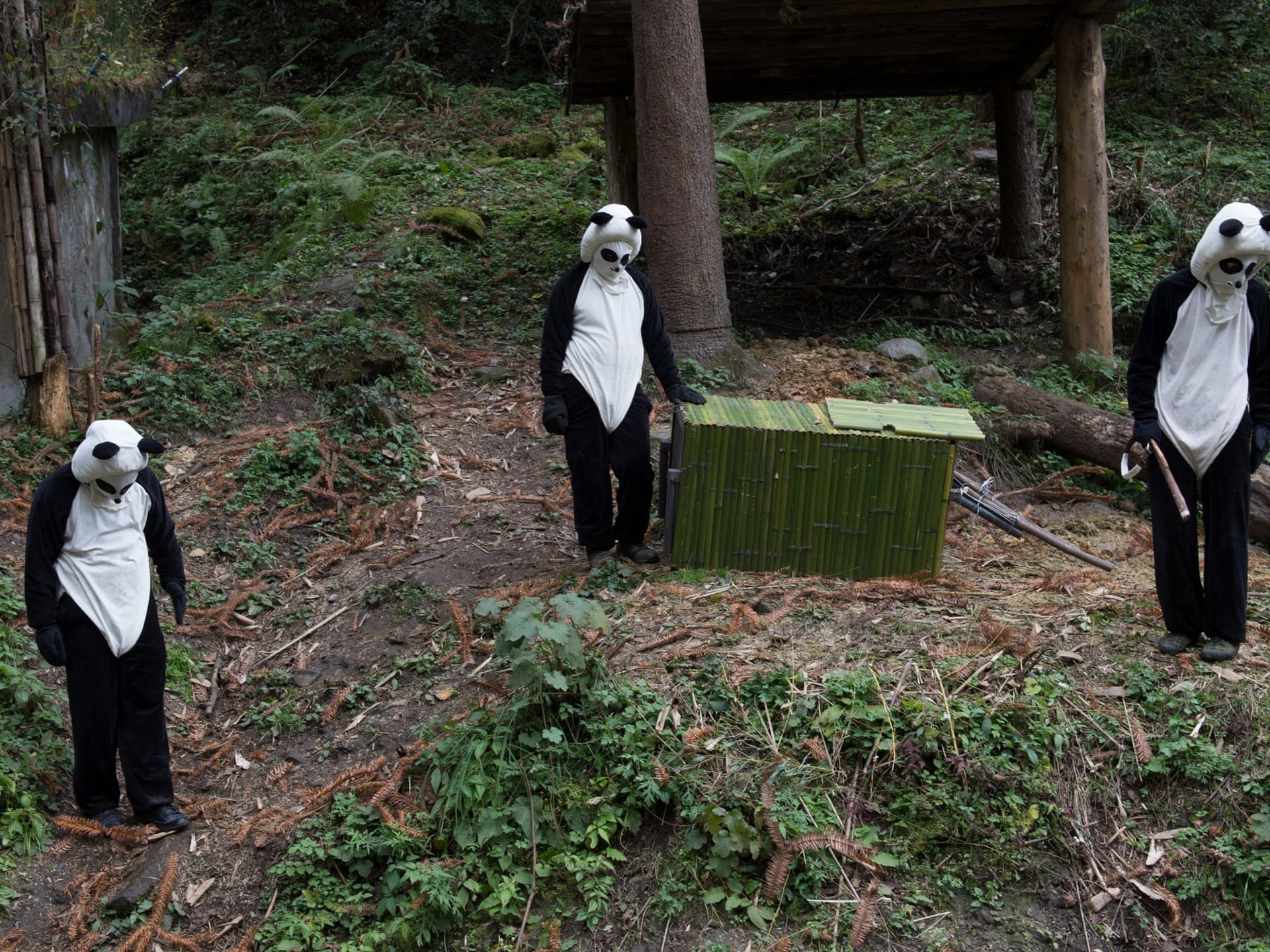
A panda is moved to its next level of training at China's Wolong National Nature Reserve: photo by Ami Vitale via The Guardian, 23 April 2014
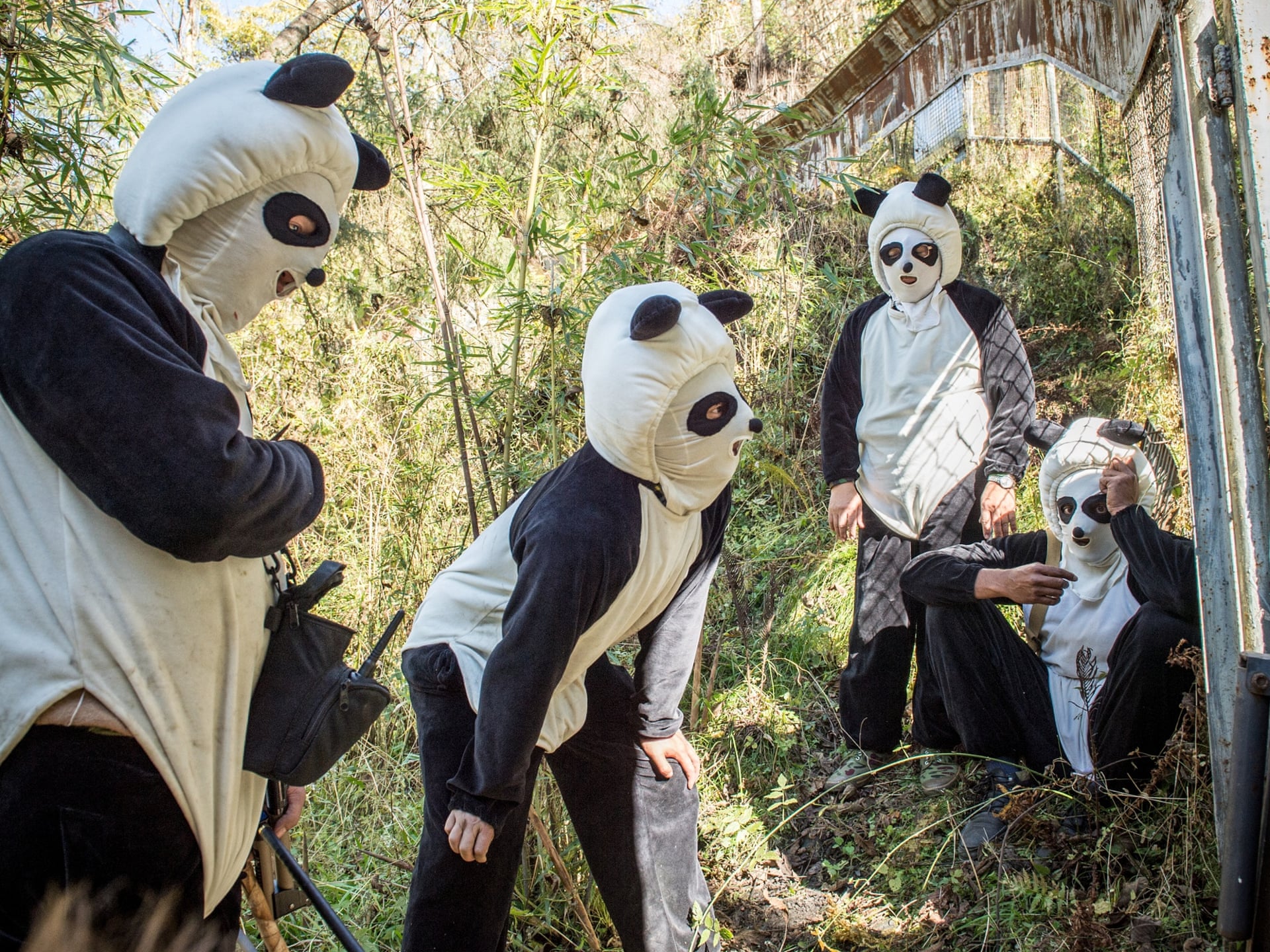
Panda keepers wait for a panda to leave its cage into the Wolong National Nature Reserve at the Wolong National Nature Reserve in China: photo by Ami Vitale via The Guardian, 23 April 2014
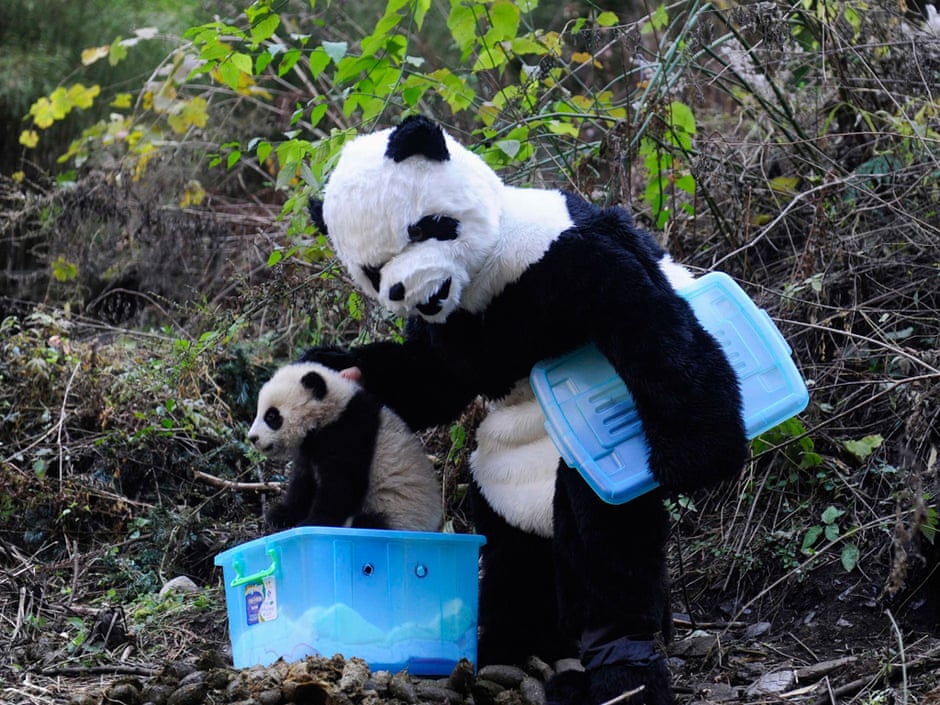
A researcher dressed in a panda costume puts a panda cub into a box before its physical examination at the Hetaoping Research and Conservation Centre for the Giant Panda in Wolong National Nature Reserve, China: photo by Reuters via The Guardian, 7 December 2010
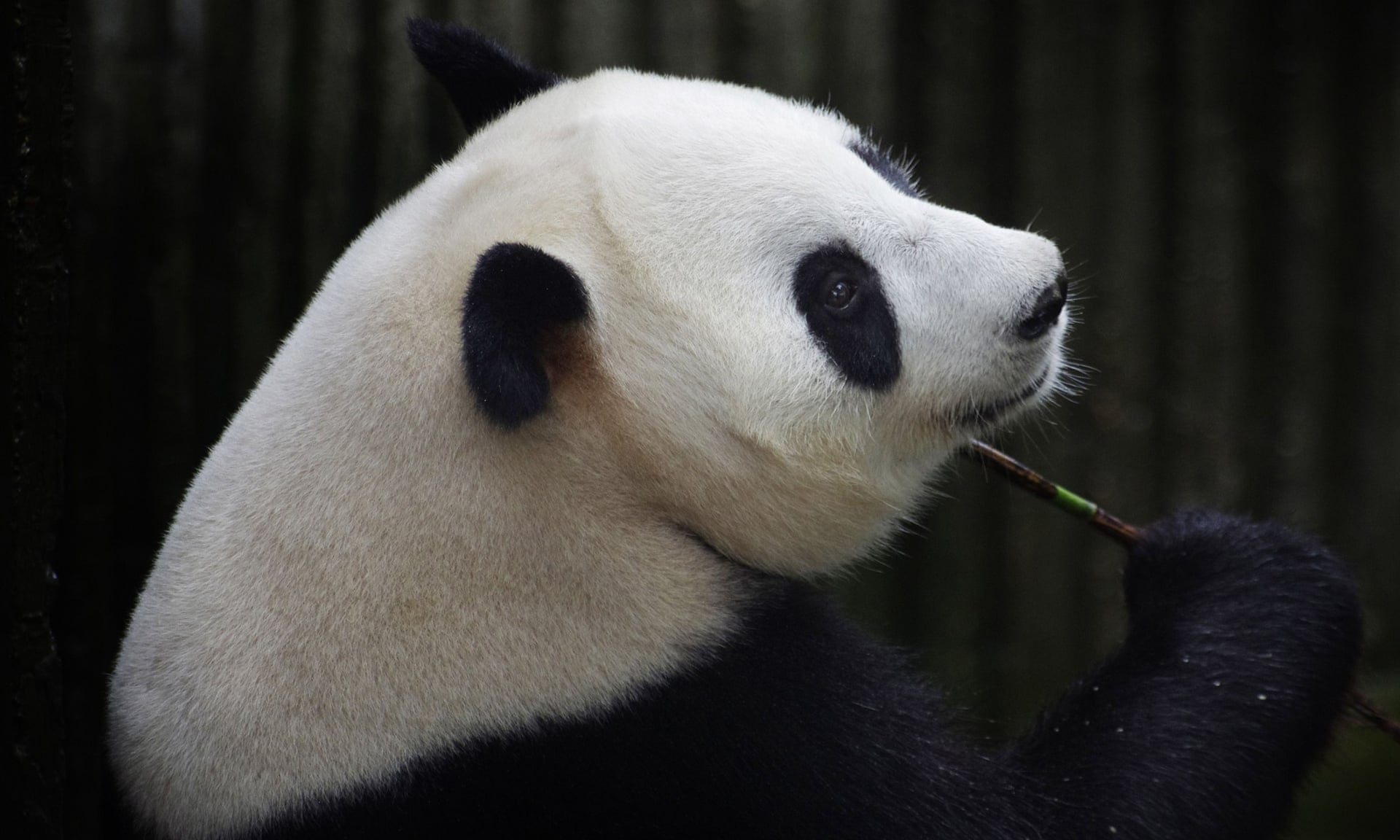
Four giant pandas at a Chinese rescue centre have died from the canine distemper virus: Photograph: AFP via The Guardian, 6 February 2015
Beyond Gaming: The Shrinking World of the Living: Pablo Neruda: Keeping Quiet
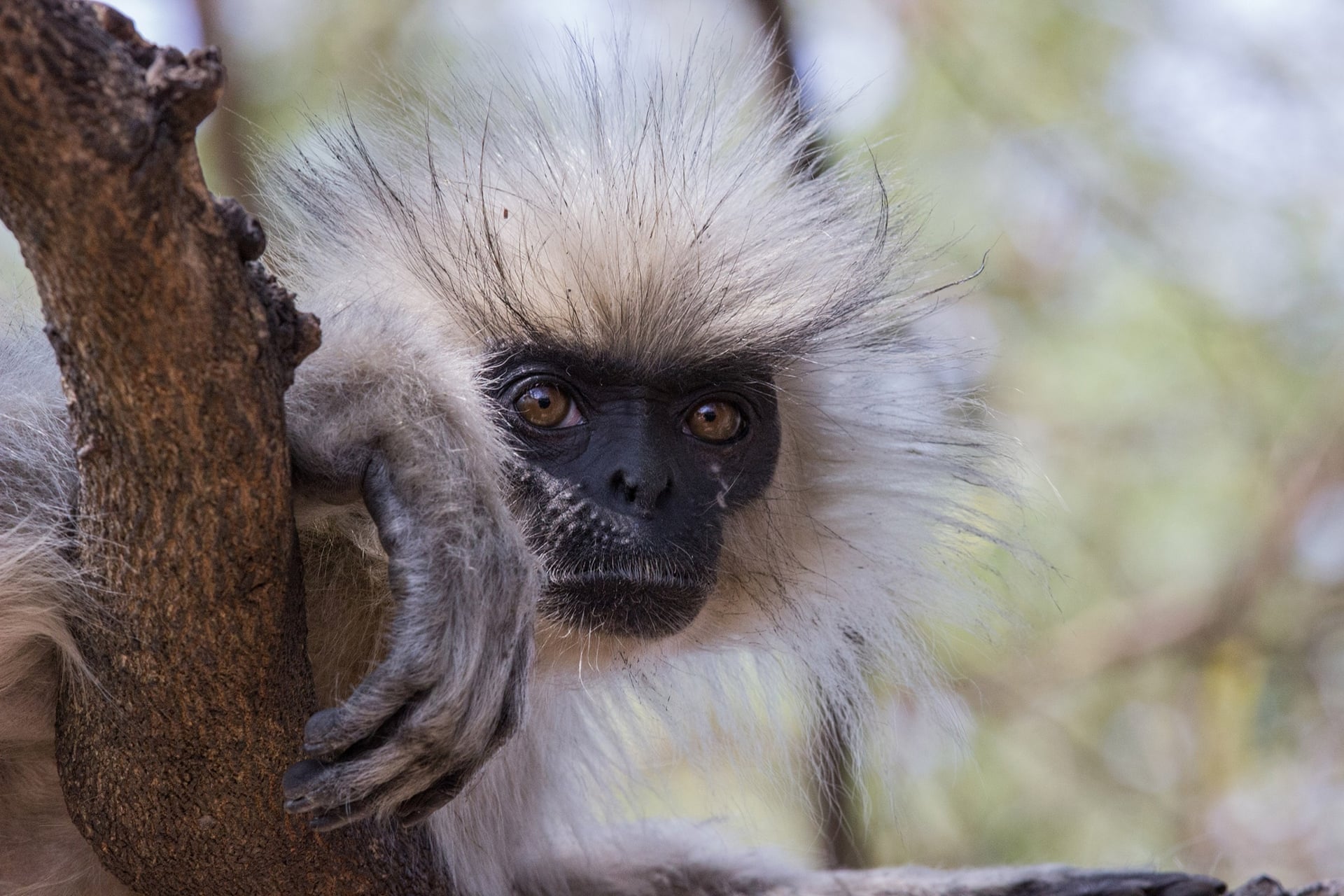
A golden langur on an island in the Umananda river in Guwahati, in Assam. The langur is one of India’s most endangered primates: photo by Partha Hazarika/Barcroft India via the Guardian, 27 March 2015
Now we will count to twelve
and we will all keep still.
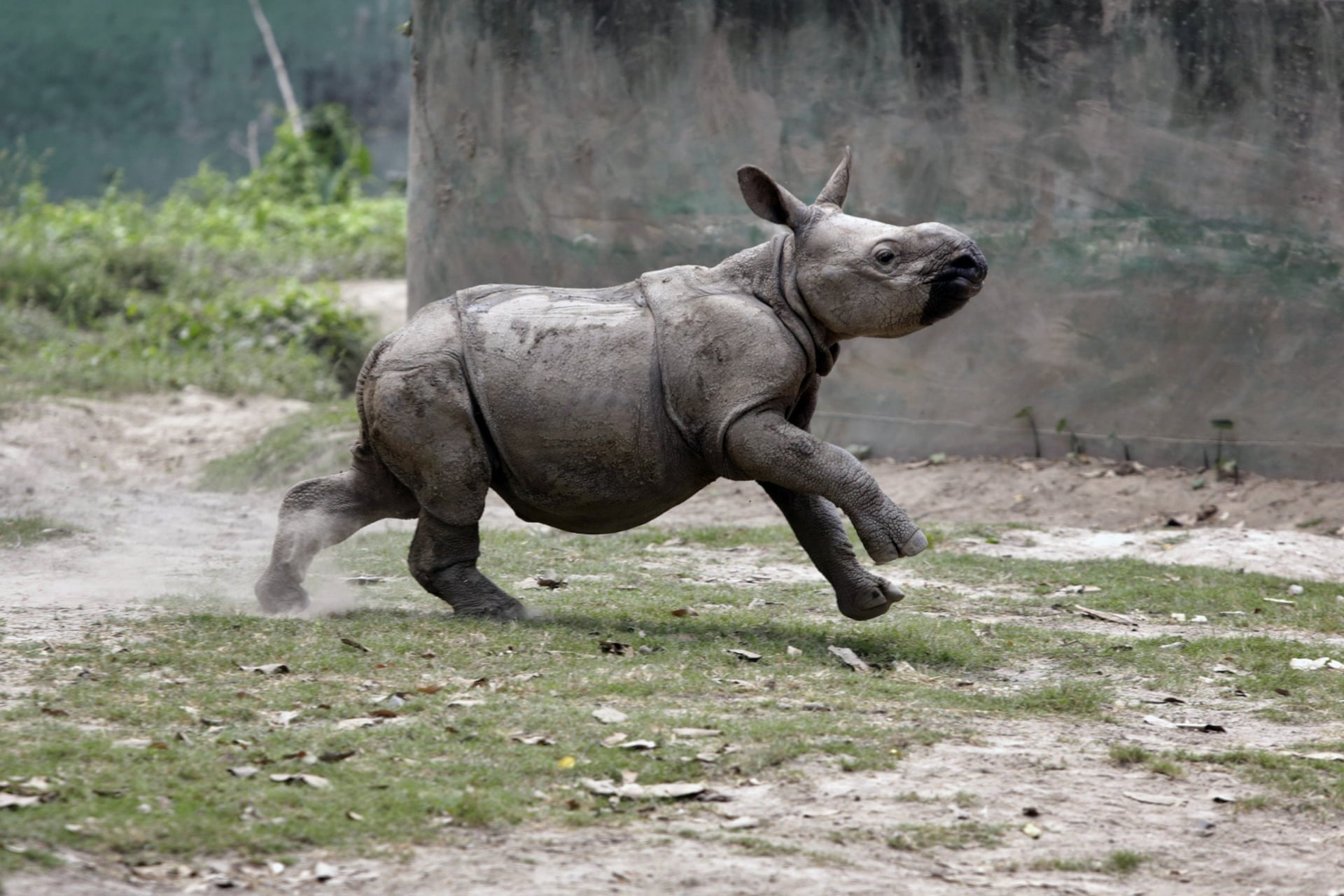
Kolkata, India. Jalada Prasad, a six-month-old male Indian one-horned rhinoceros, runs around his enclosure on his debut in front of the public at Alipore Zoological Garden: photo by Bikas Das/AP via The Guardian, 27 March 2015
For once on the face of the earth,
let's not speak in any language;
let's stop for one second,
and not move our arms so much.

An Indian one horned rhino in the Kaziranga national park, Assam, India. The park is a rhino sanctuary and is helping to revive the species and protect them from poachers: photo by Paul Hilton/HSI via The Guardian, 8 January 2015
It would be an exotic moment
without rush, without engines;
we would all be together
in a sudden strangeness.

Naypyitaw, Burma. A baby elephant, which was found in a river during the rainy season, plays with white elephants, seen as sacred signs of good fortune, peace and wealth: photo by Damir Sagolj / Reuters via The Guardian, 12 November 2014
Fisherman in the cold sea
would not harm whales
and the man gathering salt
would look at his hurt hands.
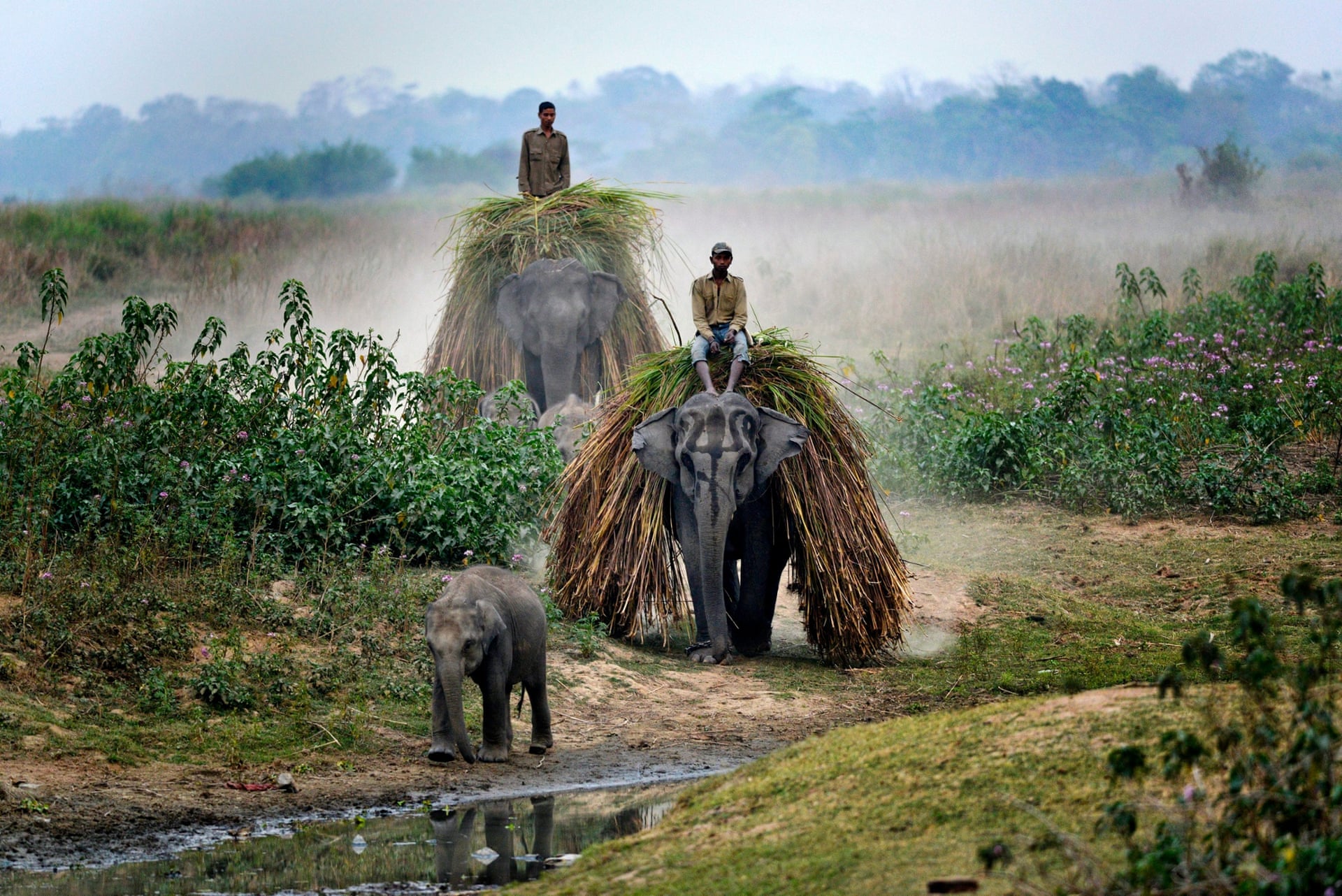
Mahouts return home with their elephantscarrying grass to feed them on the eve of the rhino census in Kaziranga national park in Assam, India: photo by TR/EPA via The Guardian, 27 March 2015
Those who prepare green wars,
wars with gas, wars with fire,
victories with no survivors,
would put on clean clothes
and walk about with their brothers
in the shade, doing nothing.

Assam, India. Forest officials count rhinos during a census at Kaziranga national park. The census takes place every two years, with 2,329 rhinos counted in 2013: photo by Biju Boro/AFPvia The Guardian, 27 March 2015
What I want should not be confused
with total inactivity.
Life is what it is about;
I want no truck with death.

Rasuruan, Indonesia. A seven-day-old female Sumatran elephant calf stands with its mother at the Safari zoo. Smallest of the Asian elephants, Sumatran elephant (Elephas maximus sumatrensis) is facing serious pressures arising from illegal logging and associated habitat loss, and fragmentation in Indonesia: photo by Fully Handoko / EPA via The Guardian, 14 November 2014
If we were not so single-minded
about keeping our lives moving,
and for once could do nothing,
perhaps a huge silence
might interrupt this sadness
of never understanding ourselves
and of threatening ourselves with death.
Perhaps the earth can teach us
as when everything seems dead
and later proves to be alive.

A billboard in Hanoi, Vietnam, reads: ‘Rhino horns are just like buffalo horns, human hair and nail. Do not waste your money,’ to mark the World Rhino Day on 22 September. This year’s theme was ‘Five rhino species forever.’: photo by Luong Thai Linh/EPA via The Guardian, 26 September 2014
Now I'll count up to twelve
and you keep quiet and I will go.
and you keep quiet and I will go.
Pablo Neruda (1904-1973): Keeping Quiet, from Extravagaria, translated by Alastair Reid, 1974
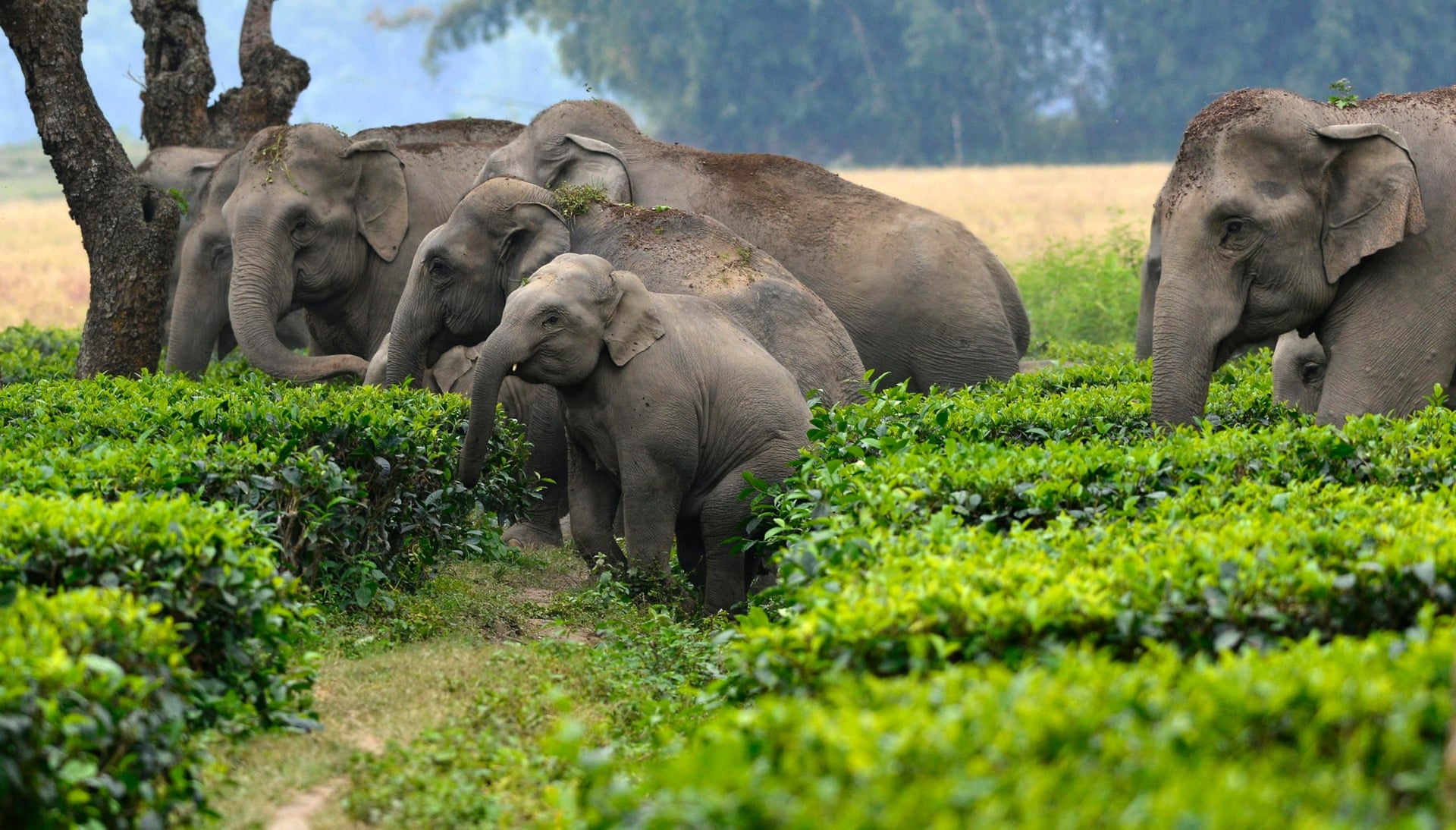
A herd of wild elephants with newborns crosses a tea garden to enter a paddy field in Sonitpur, Assam, India. According to reports, five people have been killed by the herd in the last two months and it has destroyed a large area of ripe paddy fields: photo by STR/EPA via The Guardian, 28 November 2014
Global Gaming: The Law of the Stronger

An Indian man feeds an elephant, which is hired out for weddings and parties, on the banks of the river Yamuna, New Delhi: photo by Money Sharma/AFP via The Guardian, 7 February 2015
![]()
Tiger (Panthera tigris). A Sumatran tiger named Dara, trapped by tiger poachers. Indonesian conservationists have found 120 traps set up by poachers to snare critically endangered Sumatran tigers in Kerinci Seblat national park, according to officials. Poaching is the greatest immediate threat to this endangered species, of which there are as few as 3,200 in the wild.According to Traffic, parts from a minimum of 1,590 tigers were seized between January 2000 and April 2014 – an average of two animals per week. Every part of the tiger — from whisker to tail — is traded on the black market. Tigers are mounted as trophies, skins worn as status symbols, and their parts used in traditional medicine, as tonics and folk remedies: photo by Kerinci Seblat National Park/AFP via The Guardian, 7 February 2015
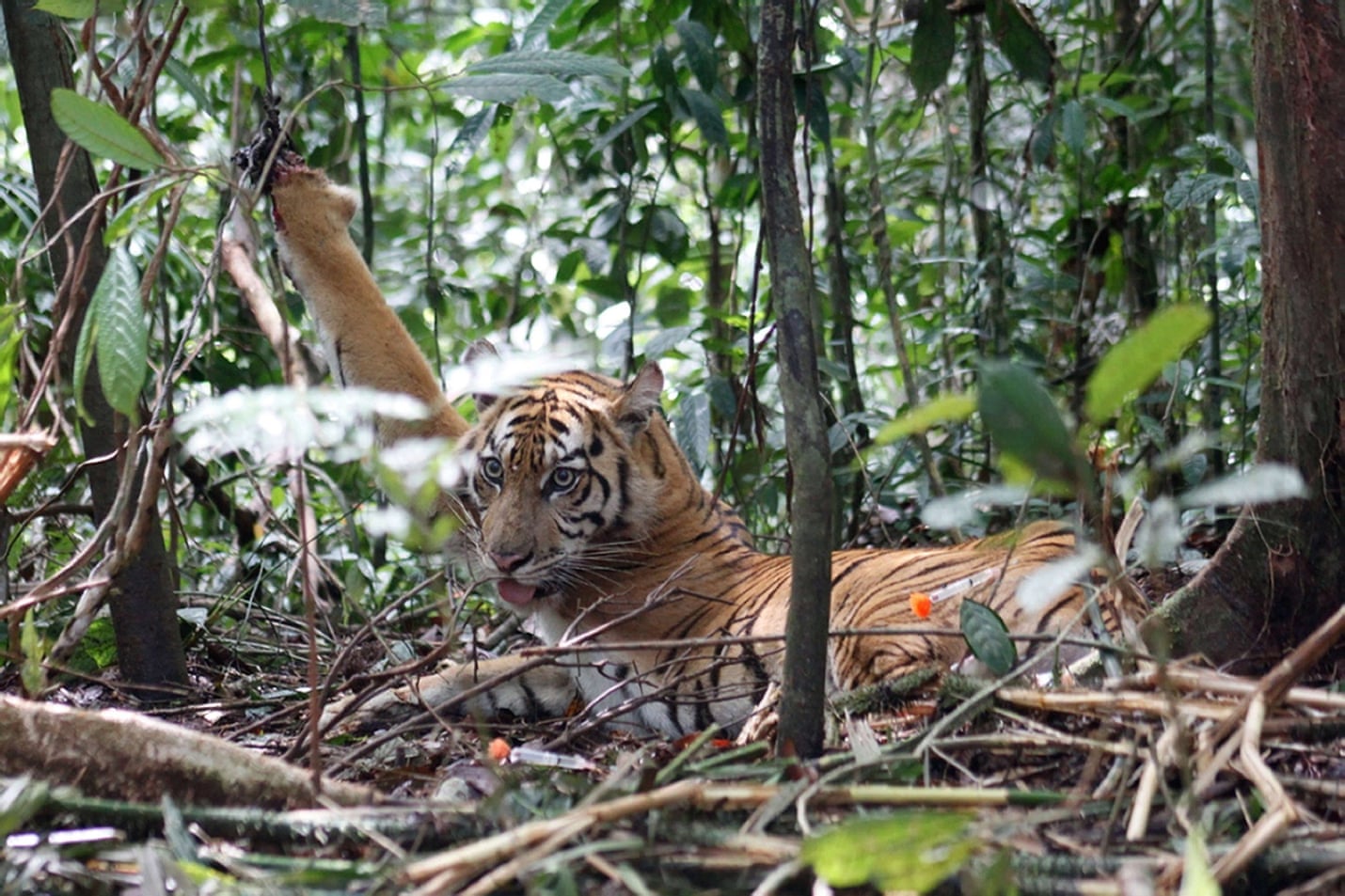
Tiger (Panthera tigris). A Sumatran tiger named Dara, trapped by tiger poachers. Indonesian conservationists have found 120 traps set up by poachers to snare critically endangered Sumatran tigers in Kerinci Seblat national park, according to officials. Poaching is the greatest immediate threat to this endangered species, of which there are as few as 3,200 in the wild.According to Traffic, parts from a minimum of 1,590 tigers were seized between January 2000 and April 2014 – an average of two animals per week. Every part of the tiger — from whisker to tail — is traded on the black market. Tigers are mounted as trophies, skins worn as status symbols, and their parts used in traditional medicine, as tonics and folk remedies: photo by Kerinci Seblat National Park/AFP via The Guardian, 7 February 2015
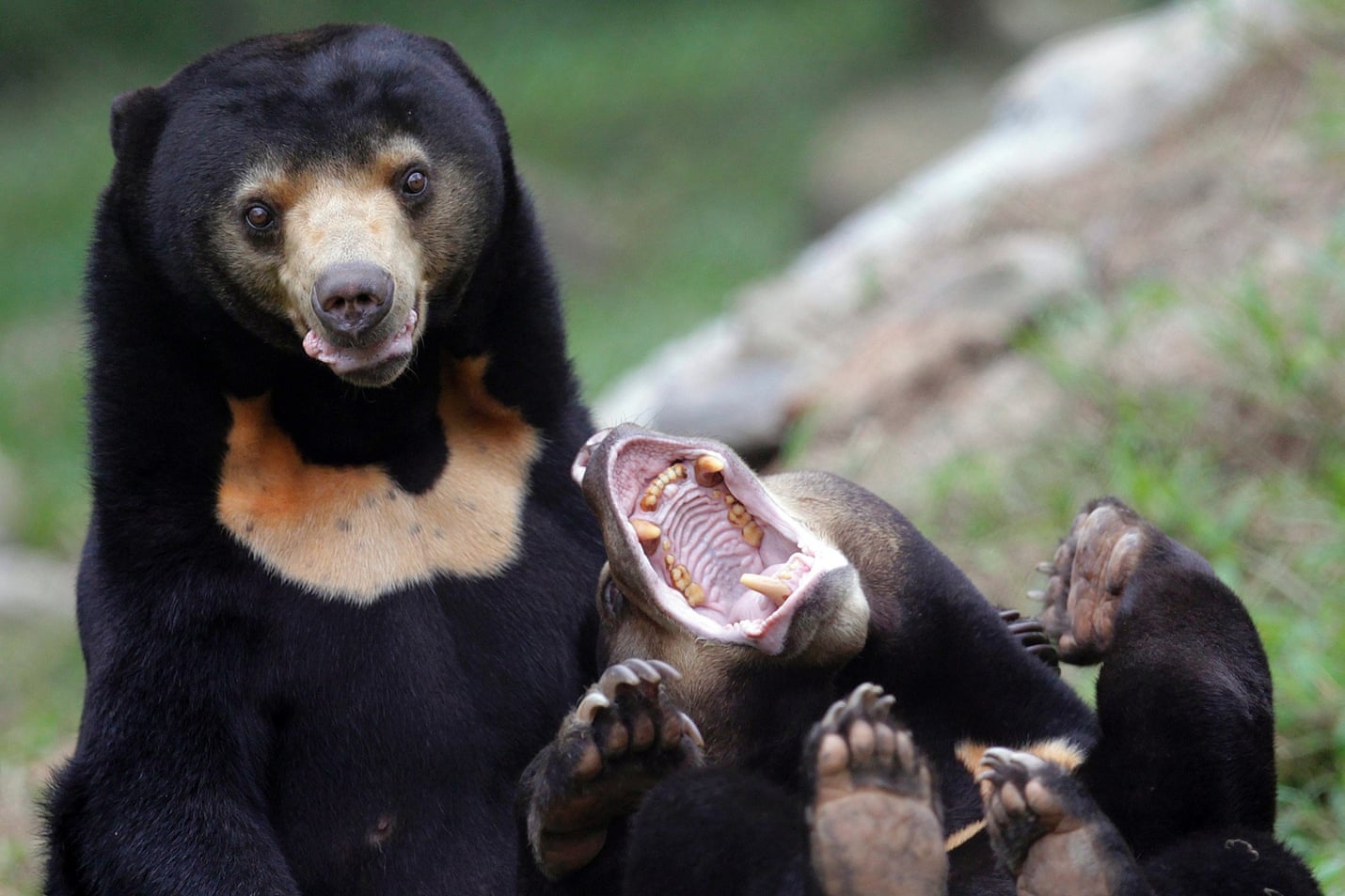
Two sun bears (Helarctos malayanus) at the Vietnam Bear rescue centre in Tam Dao national park, Vietnam. The bear’s gall bladders are used in traditional Chinese medicine and although bile is milked from commercially farmed bears, wild bears are often taken to stock or restock these small farms. Bear meat, particularly the paws, is considered a culinary delicacy. Killing bears is illegal in all bear range countries but is largely uncontrolled. The species is extinct in Singapore and has possibly become extinct in Bangladesh and China. They are banned from international commercial trade: photo by Luong Thai Linh/EPA via the Guardian, 5 February 2015
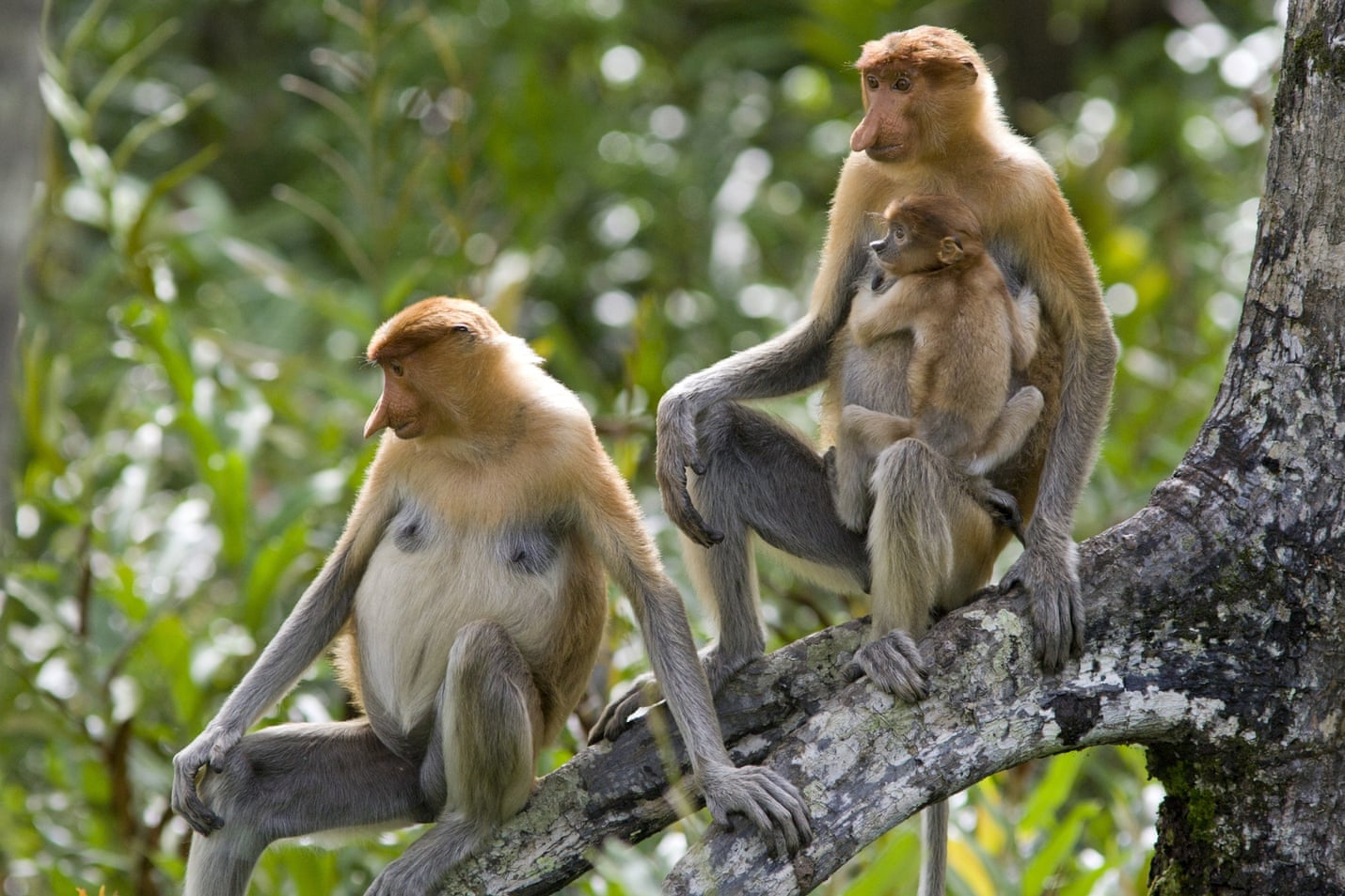
Proboscis monkey (Nasalis larvatus). This endangered species is endemic to Borneo and found in Brunei, Indonesia (Kalimantan) and Malaysia (Sabah and Sarawak). It is poached for the illegal pet trade and bush meat, and is also hunted for bezoar stones, an intestinal secretion, used in traditional medicine. In Sarawak, less than 1,000 animals are thought to remain with populations in Borneo ranging between 1,000 and just 100. Banned from international commercial trade: photo by Suzi Eszterhas/Corbis via the Guardian, 5 February 2015
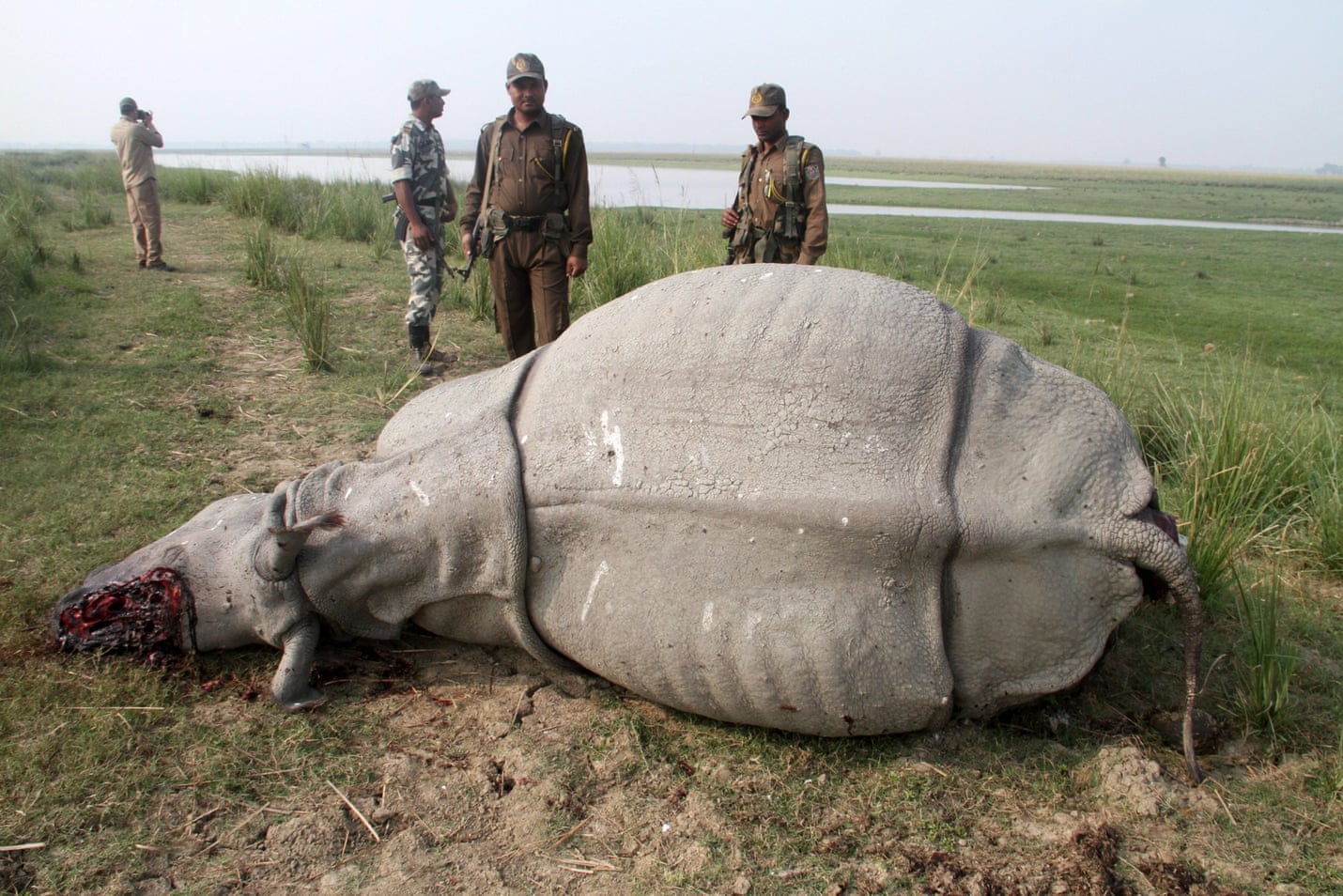
Asian rhino (Rhinocerotidae spp.). There are fewer than 4,000 wild rhinos in Asia. All three Asian species are highly targeted for their horns. Two, the Javan and Sumatran rhinos are critically endangered. The animals are killed and their horns sawn off and smuggled to their destination markets in Asia: photo by STR/EPA via the Guardian, 5 February 2015
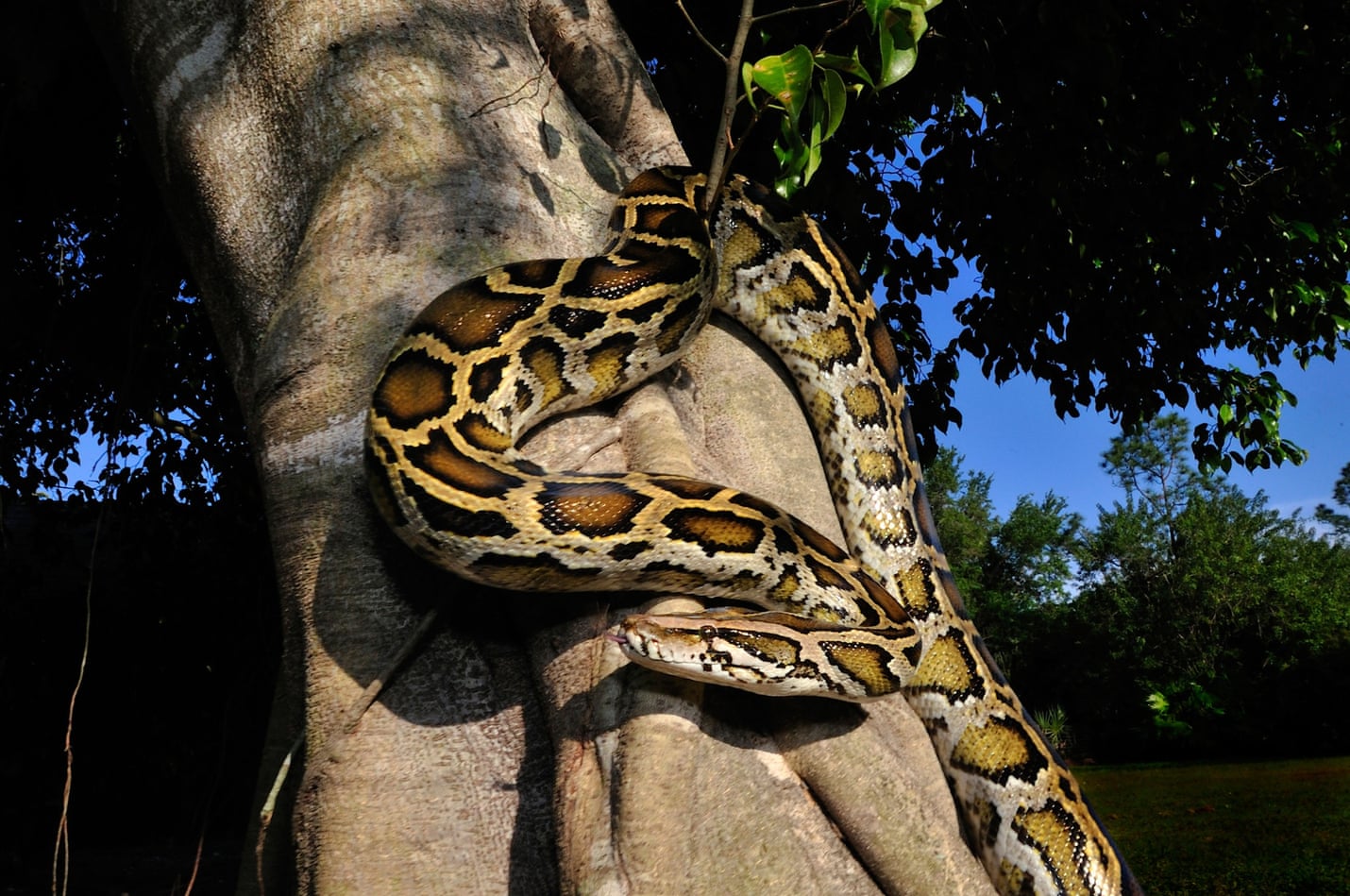
Burmese pythons (Python bivittatus) are among the most heavily traded species in Southeast Asia with approximately 340,000 skins exported annually for use in the fashion industry.Although more than 20% of exports are declared as captive-bred, a Traffic report argues that the cost of breeding, feeding and maintaining the snakes to reach slaughter size appears much higher than the market price. A skin sold in an Indonesian village for $30 can fetch up to $15,000 as a python skin handbag from a famous fashion house: photo by Mark Conlin/Alamy via the Guardian, 5 February 2015
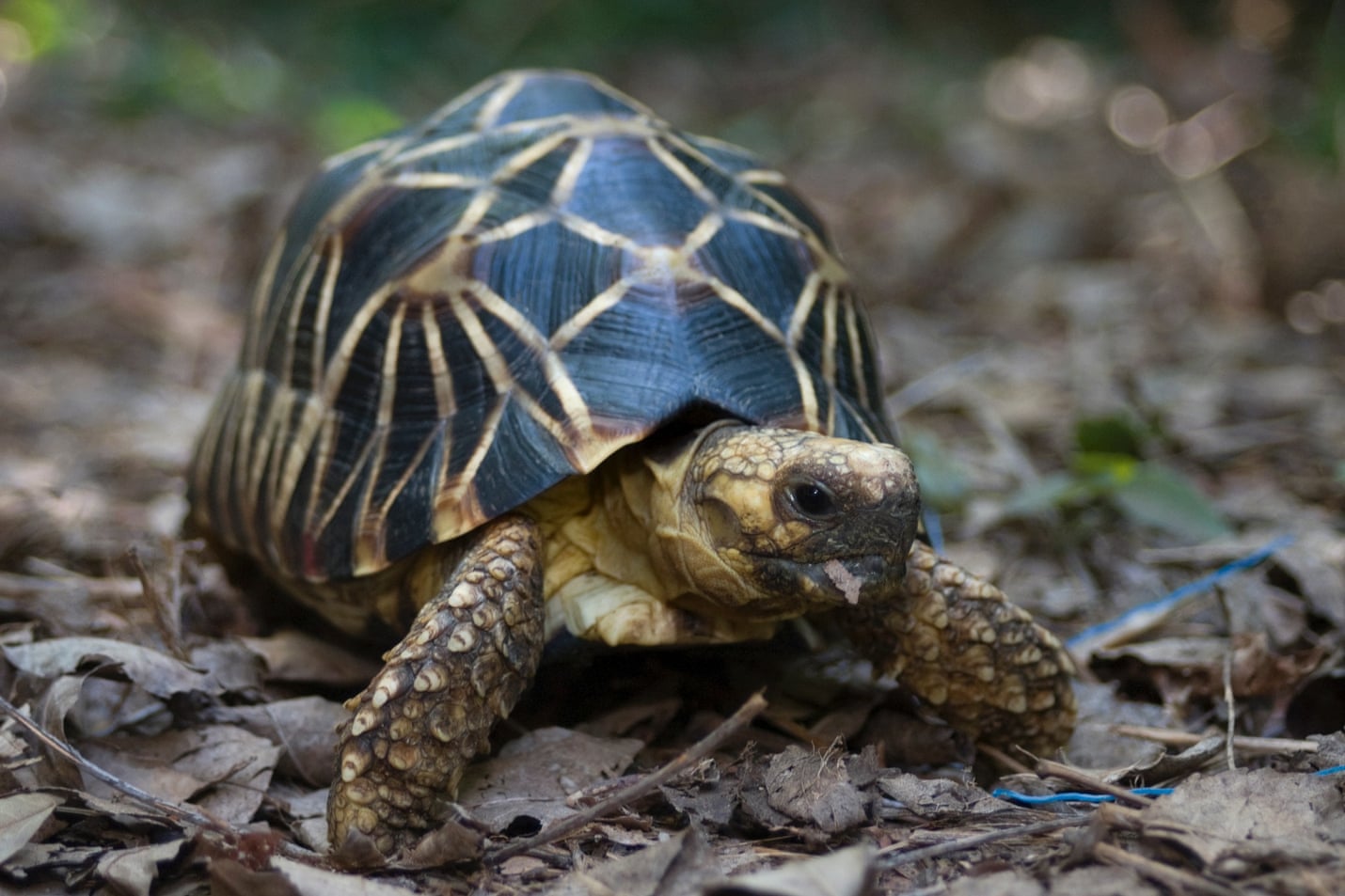
The Burmese star tortoise (Geochelone platynota), is a critically endangered species native to Burma. It is used for meat and traditional medicines in Asia and is highly sought after for the international pet trade, with collectors in Europe and North America willing to pay thousands of dollars for an individual. There are concerns that there may now be no viable wild populations. Commercial harvest and trade of this species is illegal under Burmese law, although export of captive specimens is permitted from one facility within the country, which also contributes to a future release program: photo by Minden Pictures/Corbis via the Guardian, 5 February 2015

A slow loris carried by a wildlife department official in Kuala Lumpur. It was among animals estimated to be worth $20,000, including juvenile eagles and a Malayan sun bear cub, seized during an operation against illegal wildlife traders earlier this month: photo by Olivia Harris/Reuters via the Guardian, 27 March 2015
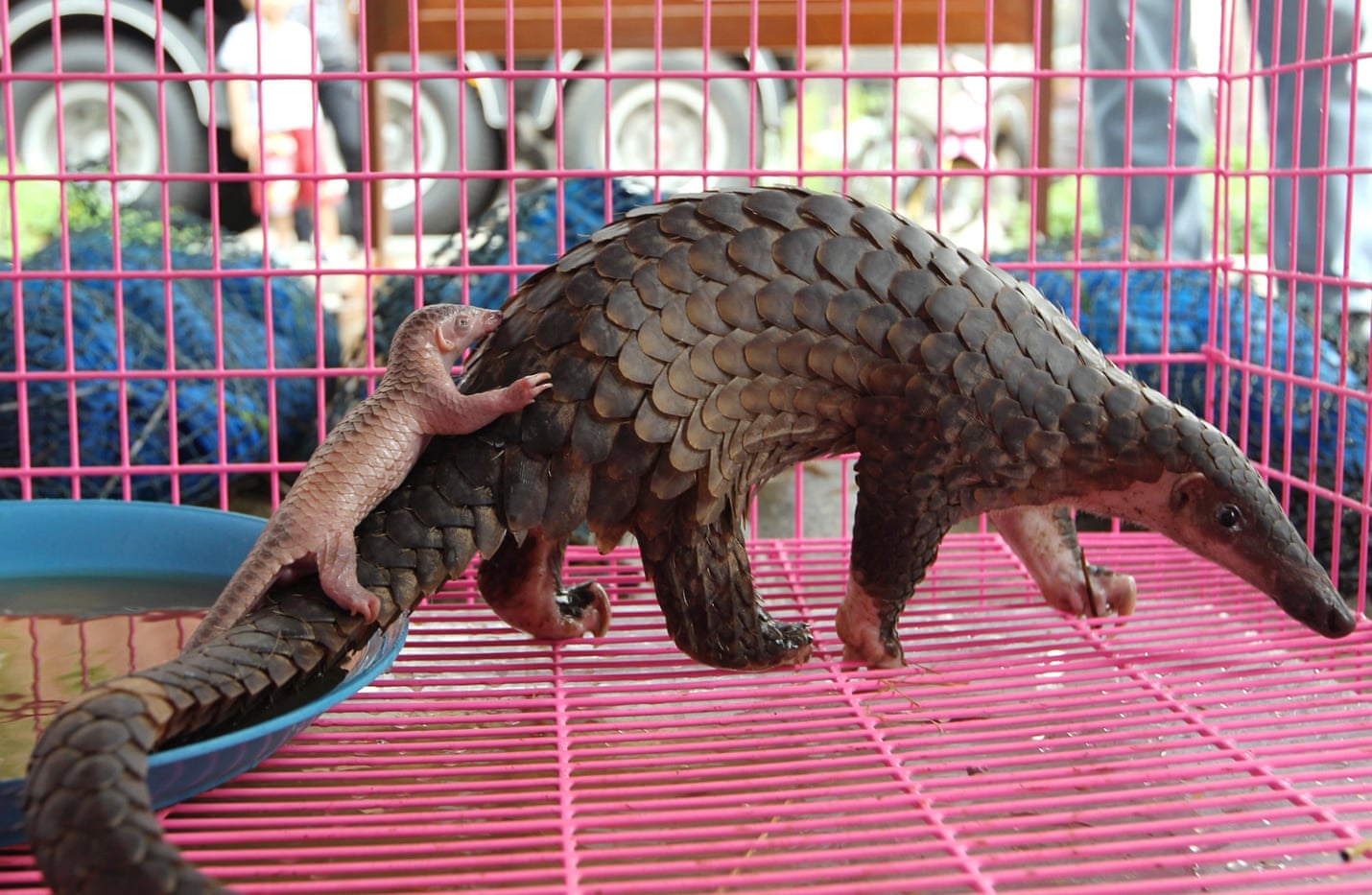
Sunda pangolin (Manis javanica) are among the most trafficked mammals in Asia.Sunda pangolin are critically endangered and IUCN reports that wild populations have halved in the past 15 years. They are in high demand both for their meat and for their scales, which are used in traditional medicine — and as love charms. Tens of thousands of Sunda pangolins have been poached from the wild, headed primarily to China where it is considered a luxury food: photo by Rungroj Yongrit/EPA via the Guardian, 5 February 2015
Gaming the Wild: Pangolin
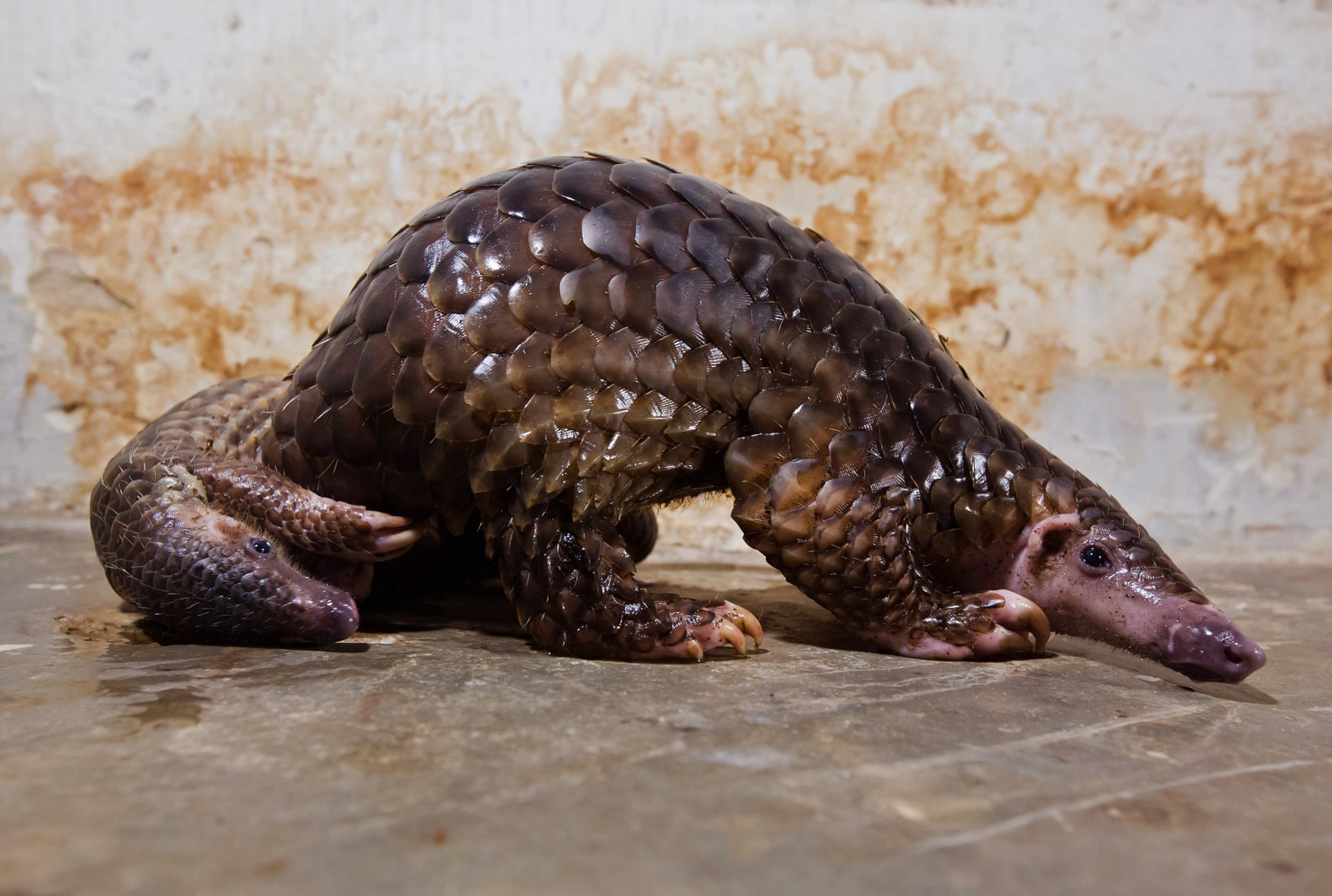
Often known as scaly anteaters, pangolins are the only mammal with scales. Their closest relatives are anteaters, armadillos and sloths. These two will end up on a dinner table in Gunagzhou, southern China, one of the areas of the world where their flesh is considered a delicacy. The illegal trade in pangolins is estimated to be worth about $19bn (£12.7bn) a year: photo by Paul Hilton for WildAid via the Guardian 10 March 2015

A critically endangered pangolin curls up into a ball to resemble a giant pine cone as a poacher nears the tree where it is trying to hide: photo by Paul Hilton for WildAid via the Guardian 10 March 2015

A poacher catches a juvenile sunda pangolin in Indonesia: photo by Paul Hilton for WildAid via the Guardian 10 March 2015
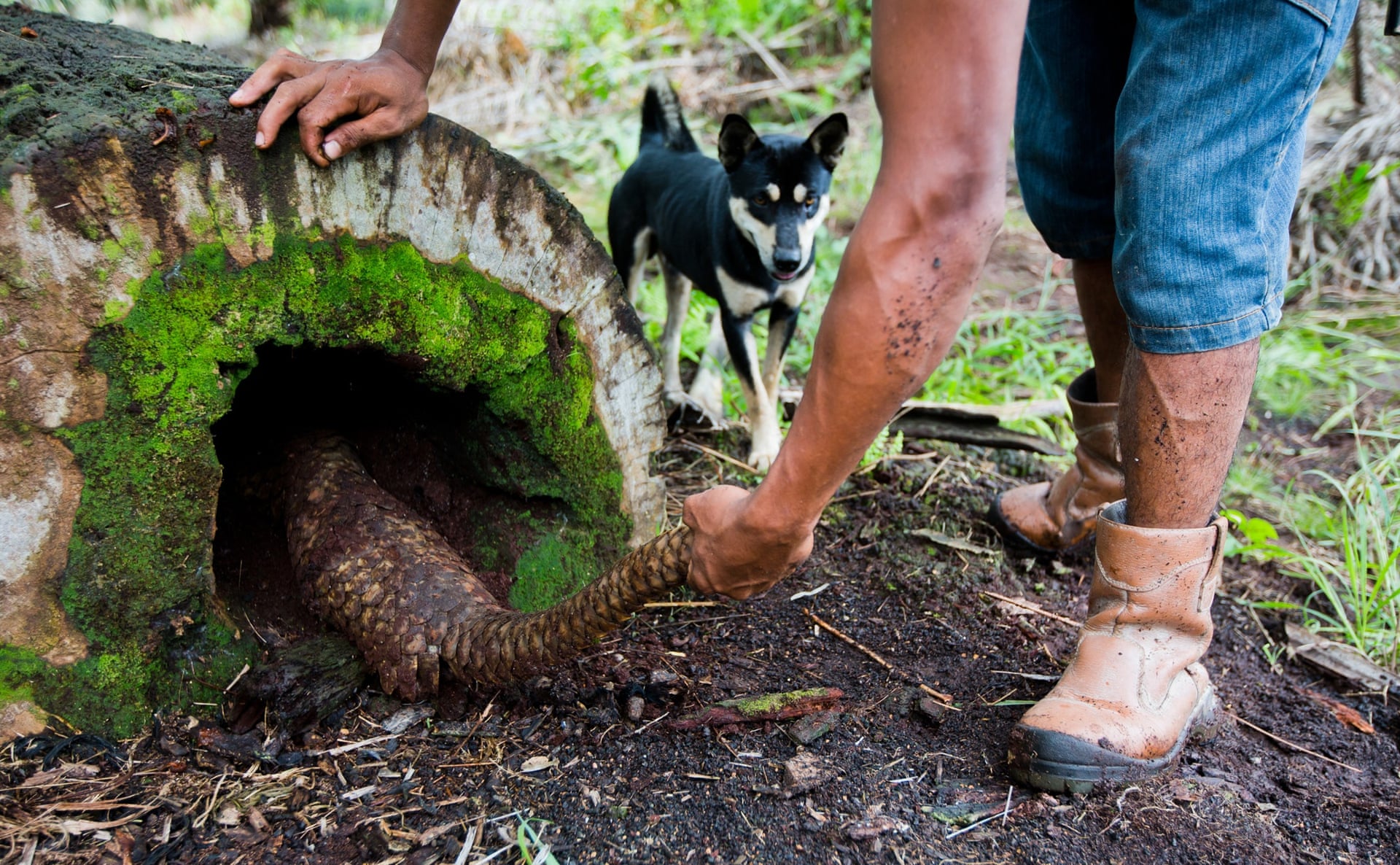
Poachers across Indonesia sell critically endangered live pangolins to middlemen for $28 (£18.70) to $31 per kilo; the average size of a pangolin is six to seven kg.: photo by Paul Hilton for WildAid via the Guardian 10 March 2015
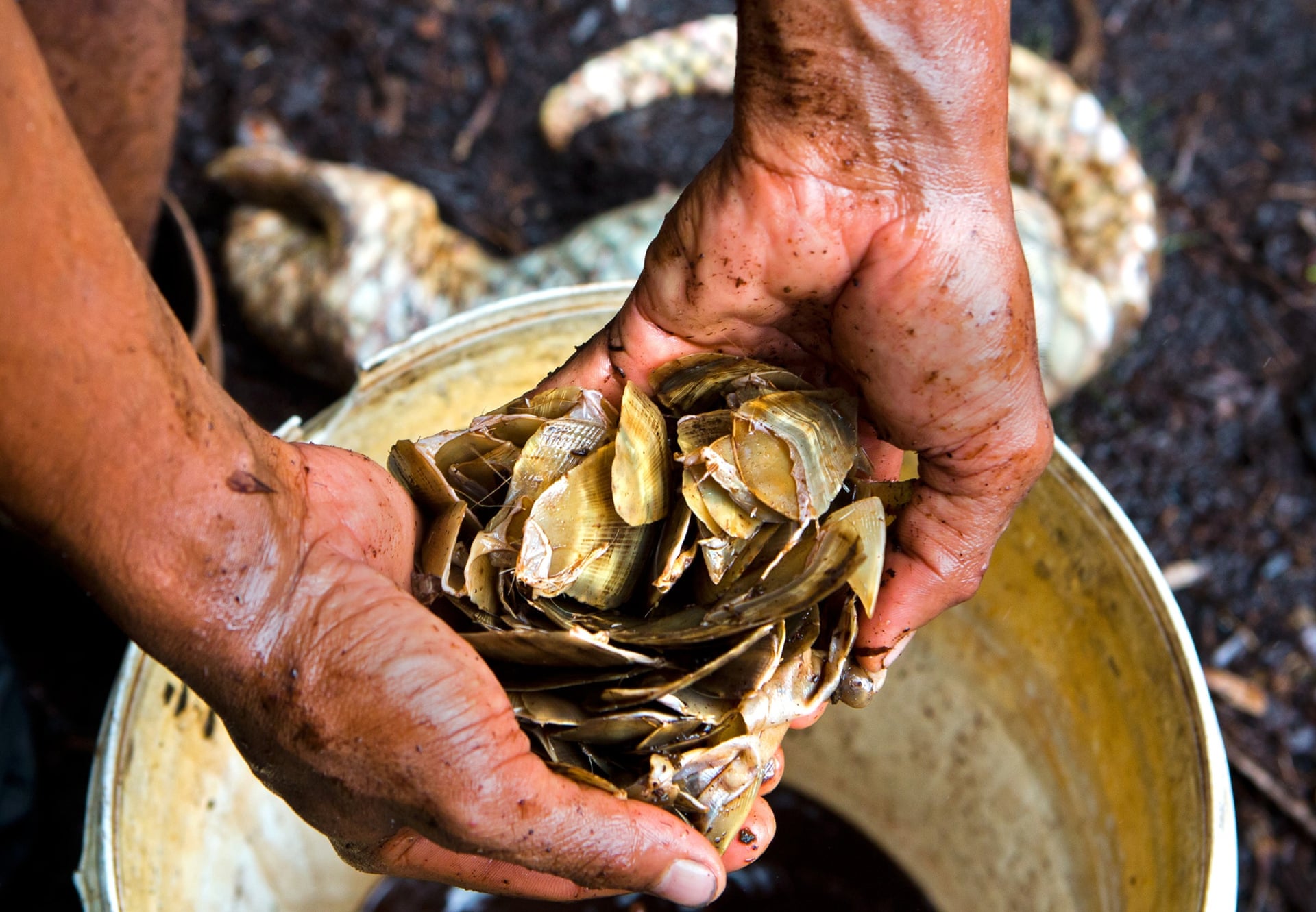
Already this year 125kg of pangolin scales were intercepted by the Indonesian authorities en route to Hong Kong: photo by Paul Hilton for WildAid via the Guardian, 10 March 2015

A poacher holds up the skin of a pangolin with the scales still attached: photo by Paul Hilton for WildAid via the Guardian 10 March 2015

The sunda pangolin (Manis javanica) is one of two Asian species of pangolin listed as critically endangered on the IUNC red list: photo by Paul Hilton for WildAid via the Guardian 10 March 2015
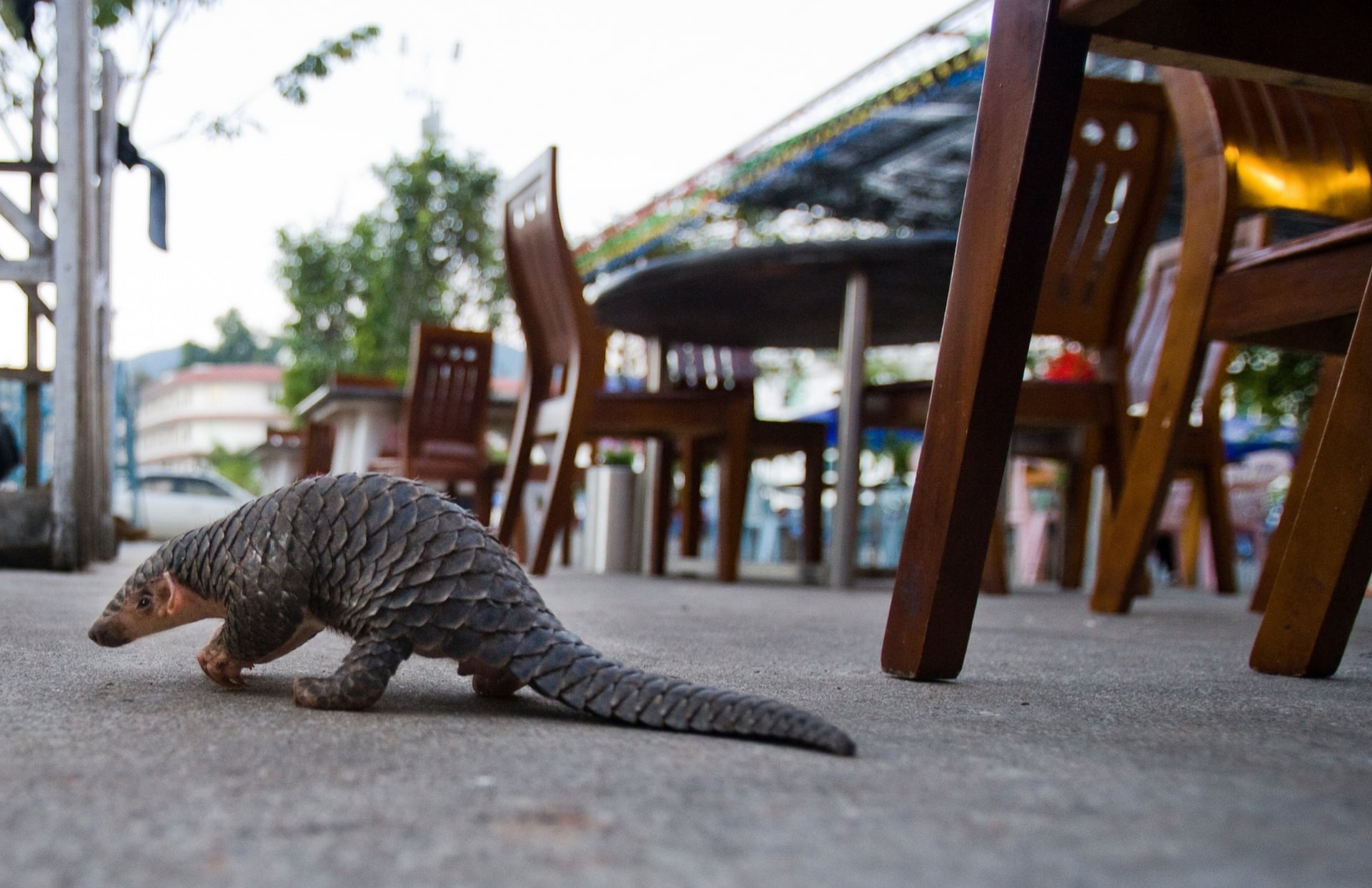
Pangolin are a bit like a friendly, flightless dragons. Many of them have no problem being around people: photo by Paul Hilton for WildAid via the Guardian 10 March 2015
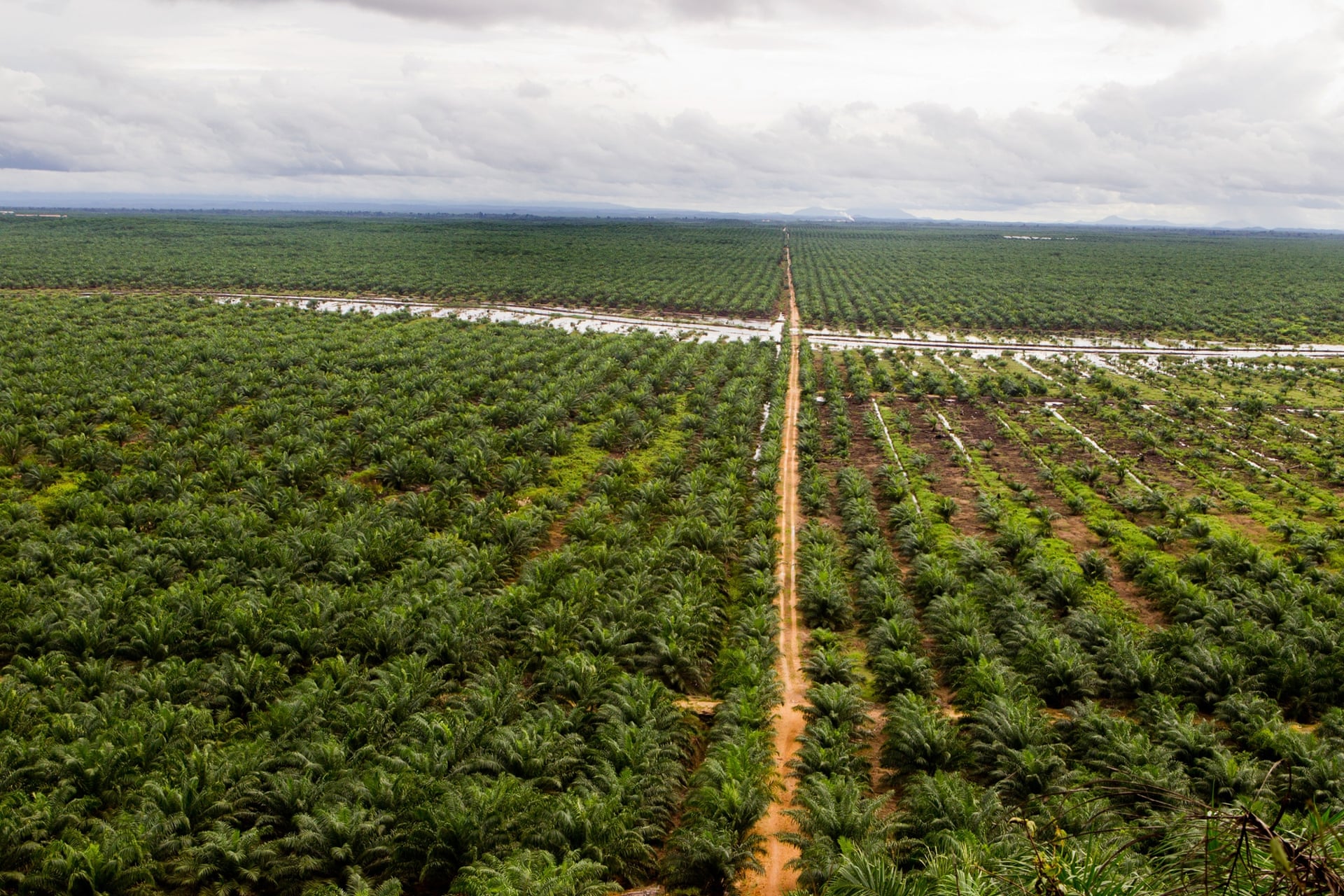
Palm oil plantations, such as this one covering thousands of hectares, are causing habitat-loss for many Indonesian species, although pangolins are one of a few that have limited tolerance to palm-oil habitats. The average monthly wage for an Indonesian working full-time on a plantation is $47 and many turn to poaching because they can earn 10 times as much: photo by Paul Hilton for WildAid via the Guardian 10 March 2015